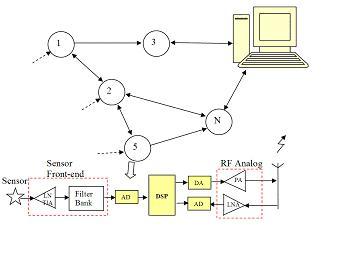Contribute
| Technology - Recent Trends In Solid-State Sensors For Gas And Chemical Sensing |
Sameer Sonkusale
01/13/2005
(This article is sponsored by The Boston Group)
There is a growing need for detection of hazardous substances (toxic
gases, chemicals) in a hostile environment for security and industrial
applications. Most current technology for such purpose use optical
techniques which are expensive, bulky and need cumbersome manual
operation. Hence they are not suitable for use in most hostile
environments. Solid State sensors offer a convenient alternative due to
their low-cost of manufacturing, portability, and low power
consumption. CMOS technology in particular enables integration of the
physical sensor, and circuitry for measurement and analysis on the same
chip or a package, thereby lowering cost through mass production.
Currently, solid-state sensors are heavily used in the industrial and
automotive markets.
Detection Using Distributed Sensor Network
Detection of gases and chemicals in hazardous environments requires
remote measurement without manual intervention. If the contaminant is
sparsely distributed in the atmosphere, multiple deployments of sensors
are needed. In such situations, one uses a distributed sensor network
for data gathering. Such network consists of a massive array of
intelligent low-cost sensor motes physically distributed in an
atmosphere for detection (Fig. 1). Each network node contains a sensor,
its interface electronics, DSP, and a RF transceiver. The computer at
the receiving end performs signal processing of the distributed data to
extract accurate sensor information.

Figure 1. An example of distributed sensing using N redundant sensors.
AD and DA represent A/D and D/A converters, PA is the power amplifier,
and LNA is a low-noise amplifier. An advantage of a distributed network
is accurate detection through averaging and redundancy inherent in the
network.
It can be shown that such a distributed ah-hoc
network offers a very high signal to noise ratio in monitoring the
enviorment, and an average low cost of deployment. The most critical
design parameters for such a distributed network are 1) The number of
sensors 2) Energy/bit of transmission, 3) Life-time of a battery for an
individual sensor 4) Selectivity and Sensitivity of individual sensors
which depends on the physical sensor and the electronics. In this
article, we will focus on some of the recent and newly developed
techniques for implementing highly selective and sensitive sensor
systems. Such a sensor system consists of an improved solid-state
physical sensor and a highly sensitive measurement circuitry built on
chip.
Majority of current sensors have an active film (such as
oxide, polymer or metal) coated on the surface. To achieve high
selectivity, the film needs to be prepared with specific receptors that
respond only to certain types of analytes. Some of them are ISFET,
ENFET and MOSFET and will be discussed in the next issue.
You may also access this article through our web-site http://www.lokvani.com/

